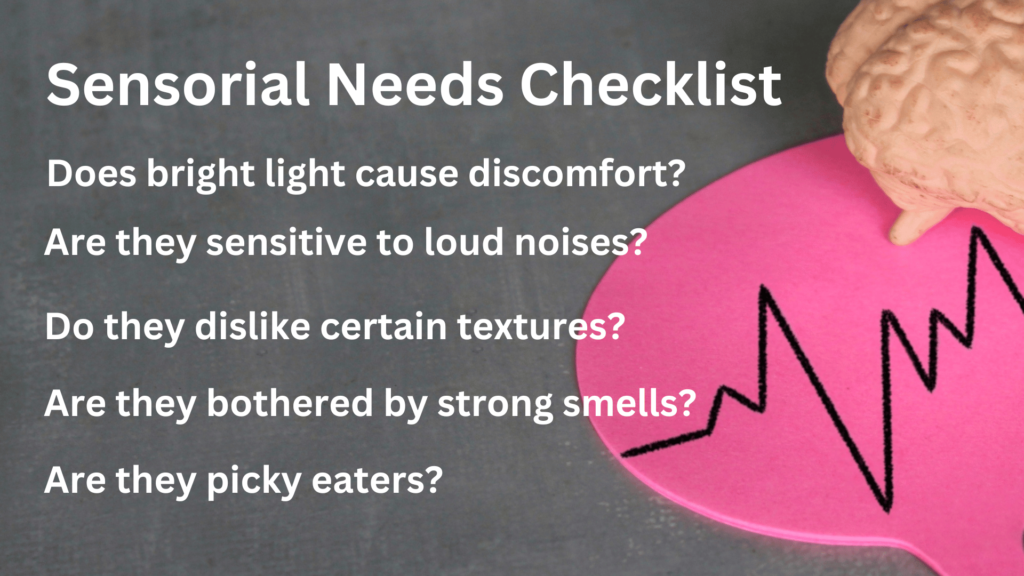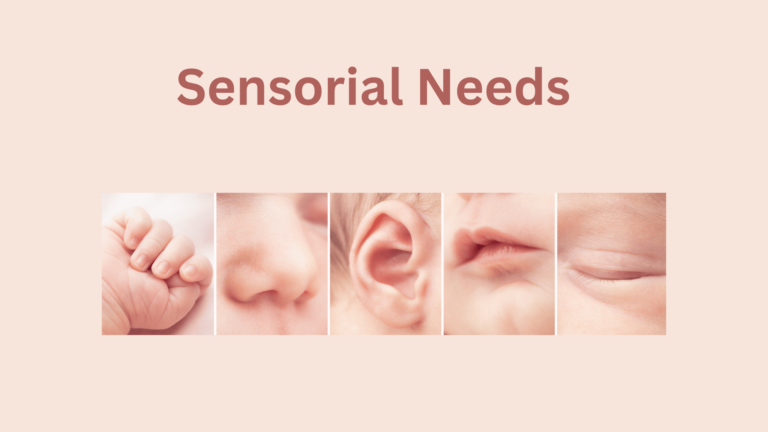Understanding Sensory needs sum up the required requisites of the sensory system for apt excitement and balance. Comprehensive range of inputs form sensory needs, pass over from visual and auditory stimuli to tactile sensations, tastes, smells and muscle sense experiences. However, Notably usual among individuals, struggle with sensory processing disorders or neurological ailments. Moreover, We shall review the pivotal roles assumed by sensory occupational therapy and sensory physical therapy in helping individuals struggling with sensory processing complicacies.
Sensorial Needs Checklist
A sensorial needs checklist can be a valuable tool in this process. This checklist typically consist of questions related to how an individual responds to various sensory stimuli across different ways, including:

Sight in Understanding Sensory Needs
Does bright light cause discomfort? Are they easily distracted by visual clutter?
Hearing in Understanding Sensory Needs
Are they sensitive to loud noises? Do they have difficulty focusing in noisy environments?
Touch in Understanding Sensory Needs
Do they dislike certain textures? Are they averse to physical contact?
Smell in Understanding Sensory Needs
Are they bothered by strong smells? Do they find certain scents calming?
Taste
Are they picky eaters? Do they have strong preferences or hatred to certain tastes?
Vestibular (balance):
Do they enjoy movement activities? Are they prone to dizziness with minimal urging?
Regarding muscle sense (body awareness)
Do they exhibit signs of clumsiness or lack of coordination? Are they unaware of their body position?
The sensorial needs checklist can serve as an initial step for additional investigation and potential professional analysis.
Role of Sensory Needs for ADHD in Understanding Sensory Needs
ADHD, identified by explanations nearly overactive, and emotional, stand as a neurodevelopmental case in Understanding Sensory Needs. Like they might be easily affected by loud noise, bright lights, or specific surface. However, They might engage in repetitive movements. They might struggle to adjust their sensory responses to different situations.
Addressing Sensory Needs for ADHD in children is crucial for creating environments that support their focus. Comprehending these sensory needs assumes of much importance in helping individuals with ADHD. Moreover, The mixture of sensorial breaking into their daily rules holds promise in making clear way for the adept management of sensory stimuli, thereby feeding support in their total welfare in Understanding Sensory Needs.
1. We can create a sensory friendly environment by providing noise- reducing headphones, fidget toys, or calming lights.
2. We can engage them in sensory activities like deep pressure massages and chewing gum.
3. We can provide occupational therapies.
Sensory Occupational Therapy for Understanding Sensory Needs
Sensory occupational therapy shapes to a special facet within the realm of occupational therapy, strictly tailored to confront the intricacies of sensory processing impediments.
However, Through the careful application of standardized evaluations and keen observations, specialists adept in Sensorial needs analysis discern the nuanced intricacies and inclinations of individual sensory processing.
Collaborating closely with individuals and their families, experts in sensory interference craft bespoke ways adjust to manage sensory input across diverse environments in Understanding Sensory Needs.
Utilizing a diverse array of activities which supports sensory mixture facilitate the sweet toned union of sensory stimuli, thereby builds up involvement and commitment in daily tasks. Sensory occupational therapy near me offers invaluable assistance to individuals feeble with a range of conditions, covering ADHD, autism, spectrum disorder, and sensory processing disorder. Consequently, This therapeutic process supply them with the needful tools and ways to cross their sensorial environment with heightened ease and assurance.
Sensory Physical Therapy in Understanding Sensory Needs
Sensory occupational therapy focuses on functional activities and participation. Physical therapists who are experts in sensory union can:
Evaluate sensorial motor responses: They assess how individuals use their bodies in response to various sensory stimuli.
Develop movement based interventions: They create exercises and activities that help individuals improve their sensory processing through movement experiences.
Promote attention control: They address hidden problems with balance and muscle sense that can impact sensory union.
Sensorial physical therapy proves very useful for individuals struggling with motor planning, union issues, or sensory response management. Moreover, its use hinges on its ability to heighten body knowledge and enhance movement clarity, fostering smoother navigation and interaction with one’s environment. Furthermore, this therapeutic model exceeds mere physical recovery, delving deep into the complex nexus of sensorial needs input and motor response, favoring a full clarity of nerves and muscle function. Additionally, through a carefully curated array of special interference, sensory physical therapy arranges a life-changing odyssey towards extreme sensory motor union and mastery of one’s physical qualities.
Conclusion
In conclusion, understanding individuals’ sensory needs is crucial for promoting and facilitating maximum benefits across diverse populations. Additionally, the sensorial needs checklist serves as a valuable starting point for identifying potential sensitivities or seeking behaviors. Furthermore, recognizing the overlap between understanding sensory needs processing challenges and conditions is essential. Moreover, addressing sensory-based intrusions in daily routines can aid in improving self-regulation and overall well-being for individuals with ADHD.

